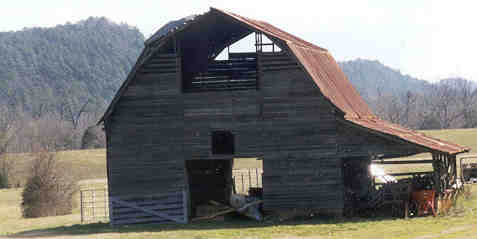
Kates Creek - March 1999. Bill Lewis' place - Lewis Bend.

Kates Creek - March 1999. Bill Lewis' place - Lewis Bend.
Take the road less traveled, Pine Ridge and Southside Rd and you will notice a few barns, wooden landmarks important to the landscape that make the past present, and a few wells in the front yards and low water bridges over the back roads of rural Montgomery County, Arkansas. Consider doing a photographic study on the barns and other interesting structures before they vanish and record where the barns are located and month and year photographed. Avoid blurred photos by understanding the depth-of-field. Be an observant photographer and avoid power-lines and ugly white skies. Often the problem is access to find the perfect angles. Select the day, a blue sky with plenty of clouds. Some structures can only be seen in the winter as they are hidden by tree branches and leaves during the summer, e.g. the Montgomery Co. courthouse.
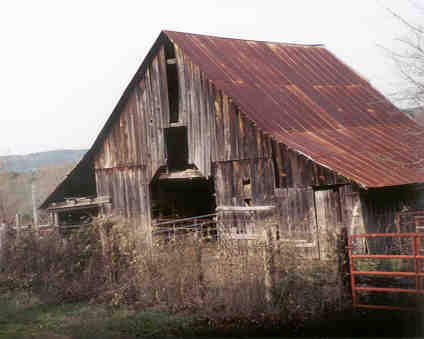
This barn west of Sims, on Hwy 88 was
owned for many, many years by Bird Stovall and later by Hezzie Summitt. Taken
Nov. 1999
Barns represent an agricultural and architectural heritage of region and way of life that is rapidly changing. Not every barn can be saved from encroaching development or easily repaired or rehabilitated for continued agricultural use or a new function without destroying the qualities that make them worth saving while maintaining their character. Periodic maintenance is essential. Water is the single greatest cause of building materials deterioration. Barns can get a new life, draw up and follow a work plan. e.g. Arts and craft shop, barn tours, place for worship services, concerts and exhibits etc. Few farmers today will choose to build wooden barns when prefab steel buildings are cheaper, faster, and easier to maintain. The functional relationship between the barn and house is significant and should also be maintained. Features, together with corrals, fences, trees, footpaths, roads, fields, woods, ponds, and other aspects of the farm setting can be important to the character of barns.
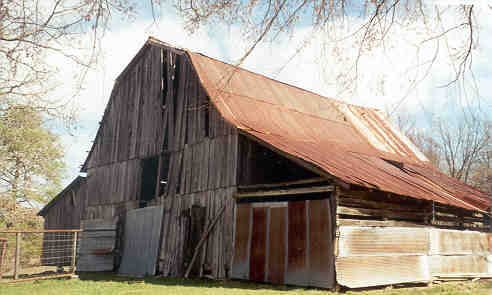
Pencil Bluff. Uncle David's barn.
Old age has crept up with a lot of the barns. Many are loosing the corrugated
iron with wind.
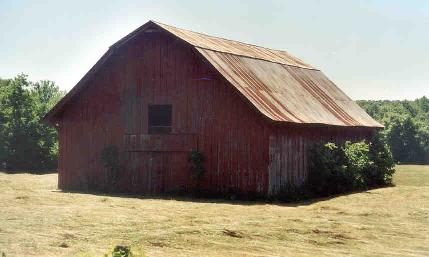
Hwy 70, three miles, north of Mt Ida toward Story. The barn will be on your right and the Whittington Cemetery will be just ahead on the left. You can almost smell the fresh mown hay and image that it will be raked and bailed in the morning if it doesn't rain. Photo taken in June 2000.
The majority of the barns in Montgomery County, AR are not
painted and have rusty corrugated iron roofs. Barn raisings have given way to
barn razing. Montgomery County, AR has been losing barns yearly and the number
is accelerating. I never got a photo of the lovely red roofed, white walled, Hal
Goodner barn in Oden was torn down in c. 2000 for the barn timber which went out
of State. Hal housed in there the covered wagon in pieces that carried the
Goodners to Oden in 1851. All that was sold at the clearing sale.
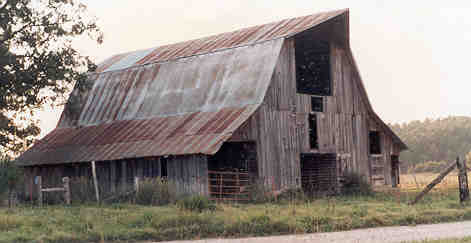
Brushy Rd, Oden (front view) Taken about 1986.
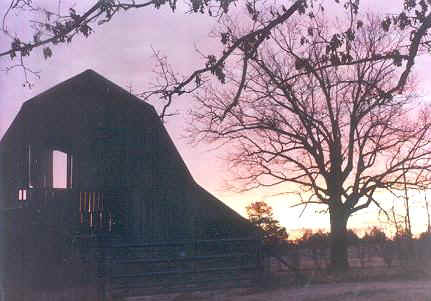
Sunrise, Brushy Rd, Oden. 2004.
Moon rise. May 2005.
Dec. 2005
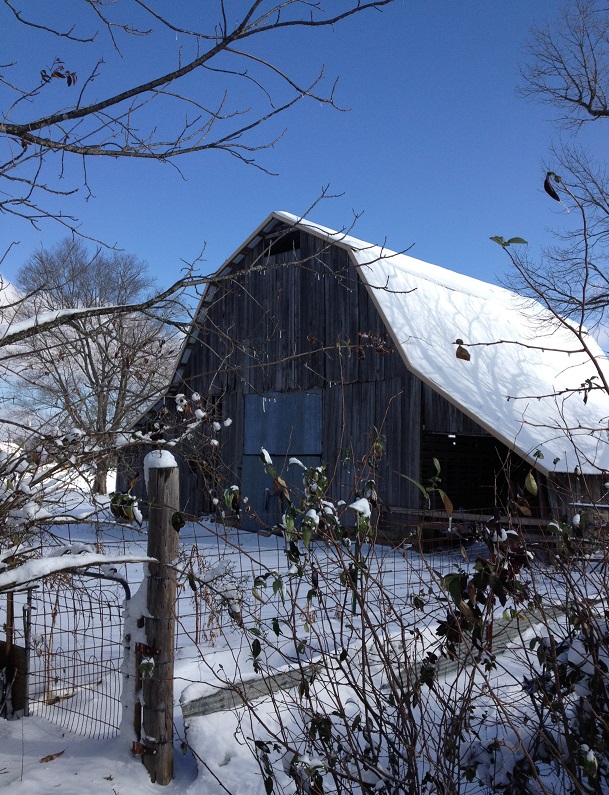
The internal volume of a barn is often a major character-defining feature of old barns. This barn is a combination of stalls and manger on the lower floor, and a large open hay loft above with openings to the hayloft from the front and back of the barn. Maybe you will also see the beginning of note cards, a barn painting in the snow, for a dear friend or a book or calendar for a fund raiser and remember the time when concrete buildings far from cities were rare.
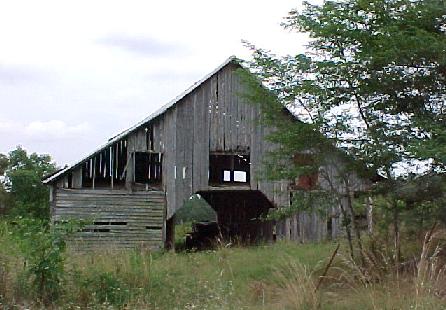
The first one is on Hwy 188, also called
the Little Fir Road. It is the Egleston farm.
Photo below also on the Egleston farm, it was a small shed used when they cooked sorghum. June 2001.
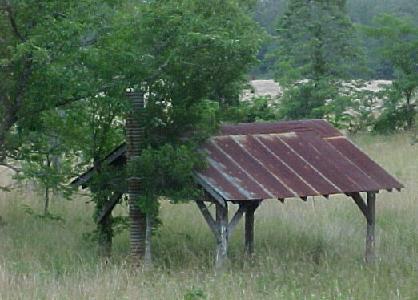
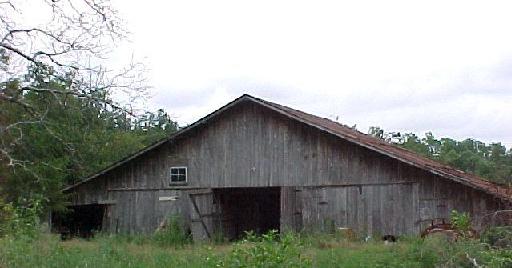
This photo one is on down the road, from the Egleston
farm, at the Clint White Farm.
Mr. White just died a few years ago at over 100. June 2001
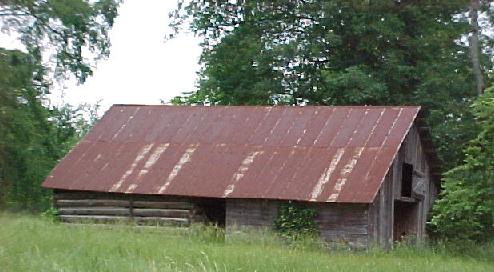
On South Fork Road on Billy
Watkins farm. Notice part is log. June 2001
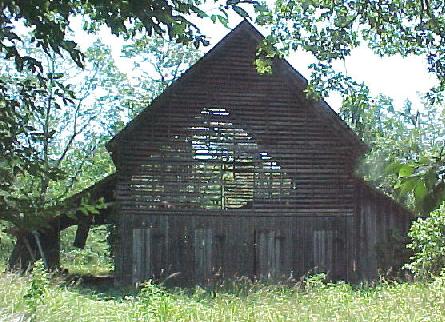
On the Campbell farm near Alamo. June 2001
Behind Pine Ridge. 2006
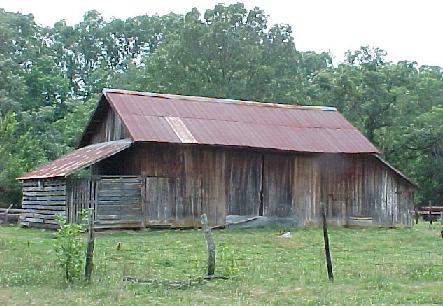
Hwy 70. Next to Sweet Home Church at the
Hughbanks farm. June 2001
There are several interesting buildings on this place, some log.
Mt Ida near the Heritage House Mueum
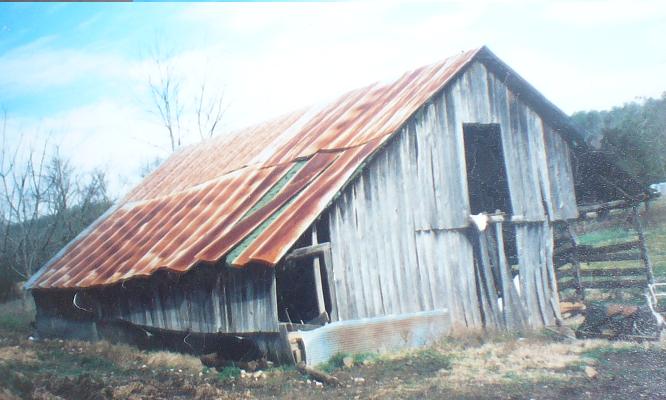
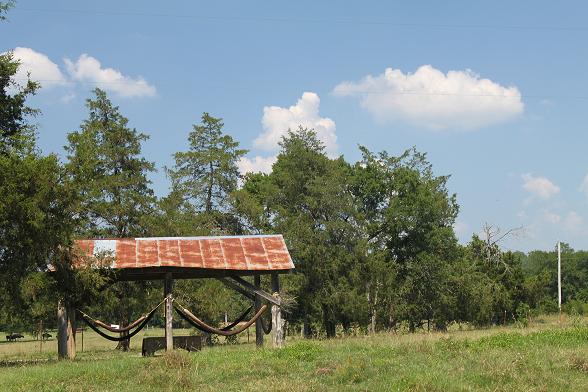
Cattle back rubbers suspended between posts, 10' rub is constructed of orlon,
polyester and acrylic, will not rot, polypropylene rope runs through core of
entire rub and at each end for hanging and charge with 4 gallons an
oil-insecticide solution mixture to control flies. Horn flies are blood-feeding
flies an their numbers peak in June, decline and then re-emerge in the fall.
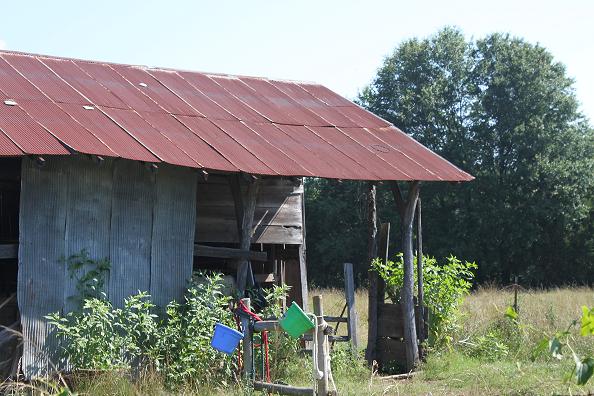
Hogs running in the bottoms or through the woods in the mountainous region of
Arkansas required no care. they were tough animals and could take an incredible
amount of punishment, as exemplified in the following tall tale;
A farmer was clearing new ground- grubbing up stumps laboriously, by hand. A
county demonstration agent came by and showed him how easily and cheaply the
stumps could be removed by the use of dynamite. The farmer was delighted. He
went to the store, bought dynamite, fuse, and caps. Coming home, he dug a hole
by a big white oak stump, set a charge of dynamite under, lighted the fuse,
and went to his house for supper. The fuse went out, but by that time the farmer
was clear of the new ground; so he decided to wait until the next morning before
lighting it again.
The next morning, early, the farmer's big razorback hog got up and went
foraging. He found that stick of dynamite and ate it. Then he saw the farmer
about the barn lot and hustled up to see if he could steal a little corn from
the mule's breakfast. He broke into the mule's stall, and made for the feed
trough. The mule, naturally kicked at him, and, for the first and last time in
his life, connected. The dynamite, at last went off.
A neighbor heard the explosion and hurried over. He found the owner leaning over
the fence of his barn lot, viewing the ruins.
The neighbor heaved a sympathetic sigh. "It looks pretty bad, friend," he said,
"pretty bad."
"Yes," said the victim, "it is bad. killed my mule, wrecked my barn, broke every
window out of one side of my house, and brother, I've got an awful sick hog."
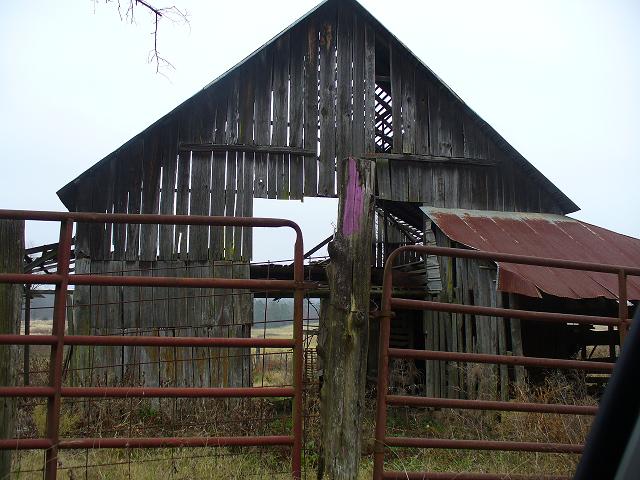
Sims, AR Dec. 2008. Looks like the iron is off the roof.
Old Barn, U.S. 70 between Mt. Ida & Murfreesboro, Ark., August, 1968
Tracking the Barns
Although Montgomery County can not boast of fine stained glass windows it does
have numerous church spires towering heavenward and barns. Maybe someone who
lives locally will consider doing a barn survey project and have the goal to
photograph and count the surviving barns over the next few years and obtain an
accurate picture of barn numbers, descriptions and condition. This count
includes not only typical rural barns but also urban barns, corn cribs, log
buildings, etc. and consider: location, setting, is it architecturally unique -
size, openings, exterior and interior shape (the complex system of beams,
braces, posts, rafters and other elements of the revealed framework create an
imposing sight), condition, decorative features, historical importance (why?),
material, function, year built and by whom, access, is it suitable for a
barn tour, wildlife, are there blueprints? Individual farmers and barn builders
sometimes added personal touches, as when they carved or painted their names on
anchor beams, or painted their names and the date over the entrance. To obtain a
history of the barn an owner can study old photographs, family records, deeds,
insurance papers, and other documents that might reveal the building's
appearance and history. Neighbors, old timers sitting on their front porches in
town, and former owners and their kin
folk are often important sources of information. The barns reflect
changing farming practices and advances in building technology. Many farmers
built their barns before they built their houses and many farm families look to
their old barns as links with their past.
National Quilt Block Project.
A rural grass-roots program to perpetuate and honor the uniquely American
art of quilting, and to provide focal points in farming
community for tours and promotion of local crafts. Big Fork, Polk County, the
first Arkansas community to join the project now has a 8' x 8' wooden painted
"Clay's Choice" quilt
block mounted on the west wall of the community general store "Big Fork Mall" in
April 2006. The rough hewn lumber was donated by the Erickson family mill and
all other materials and labour were provided by the Big Fork Quilters and their
spouses.
Agi-Tourism
Maybe in the future local Montgomery Co. AR communities can get
together and organize a project for their own general country store wall or nearby
barn. In time the County Chamber of Commerce or someone can arrange postcards
featuring all the blocks and barns. Maybe a Mystery Bus trip - charter bus fund
raiser can be organised and
have a country road quilt-barn rally a couple of weekends , e.g. local quilt
show weekend, with a tour map to show quilters, spouses, photographers, artists,
writers, history buffs, farmers and tractor enthusiasts (and there are some old
John Deer tractors around the district) and stamp-postmark collectors who can try and
obtain post marks at the various post offices in the committees and all can meet the locals
and view the back roads and smell the hay in June and the view the autumn leaves
in October.
If An Old Barn Could Talk
By Robert Seay, U of A Division of Agriculture
First posted on 06-26-2008
BENTONVILLE, Ark. - I can't recall the number of times I've heard the statement,
"If this old barn could talk, what a story it could tell." The stories could
involve unsolved mysteries or serve to enlighten us about the ambitions or
broken dreams of the men and women who spent so much of their life beneath its
roof. In traveling rural America, barns of all shapes, sizes and state of
disrepair can be seen. To earlier generations, the barn stood as a symbol, which
spoke volumes about the family who operated the farm. It represented pride and
prosperity, while also hinting of the experience and education of those who made
plans and fulfilled promises beneath its roof. Inside a barn, the fragrance of
fresh cured hay mingled with that of animals and equipment. The barn was used
for storage, to stable, doctor and market animals, grain, milk and other
produce. Terms used in reference to its strength and size were commonly
understood without further explanation. In row-crop country, barns served to
house teams of horses and mules, feed, tack and related equipment. The size of
the barn spoke of the crop acreage, the number of teams and workers that a
farmer could put in the field. Unlike today, a young, conservative farm family
may have begun with only a small shed, but to them it represented a new
beginning. The size of the barn would increase along with their experience and
success. It would be at some point in the future when a larger barn served to
inform, without words to any who passed, about the pride and prosperity of the
family who worked the land. Recently, a news reporter expressed dismay that
fewer young families were choosing farming as an occupation. The old adage, "I wouldn't wish that on anyone!" seems to fit. Debt load, weather and a 24-hour
clock that never seems to stop are obvious reasons. I would question an
undercurrent of opinion in America that farmers have outlived their purpose. The
current condition of old barns may reflect the same toll of debt load, weather,
time and having outlived a useful purpose. Even in the last century, there were
pretenders, as noted by one old-timer regarding the size of a neighbor's horse
barn. "Why, that rascal built a 20-team barn and never saw the day he could
field five teams!"
For more information about farming, contact your county extension agent or visit
http://www.uaex.edu and select Agriculture. The Cooperative Extension Service is
part of the U of A Division of Agriculture.
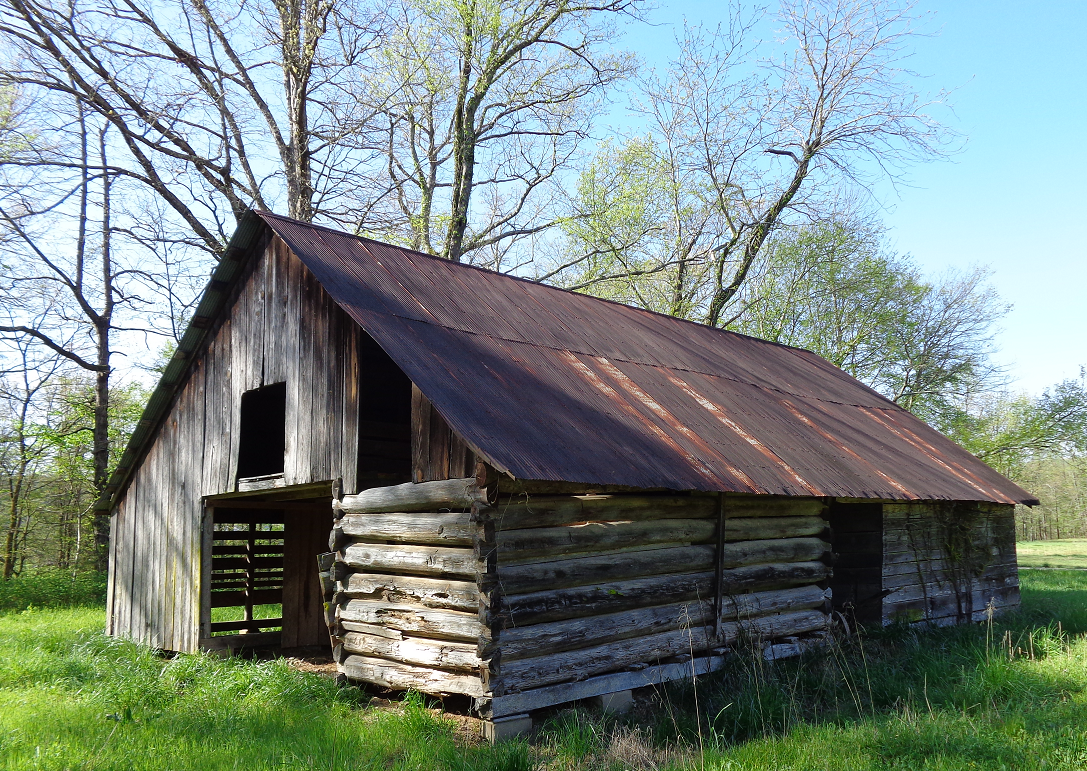
Southfork Rd. between Mauldin Rd and Mt Ida, 2016. There are at least 3 old
barns down that road.
May 2020. When driving around Montgomery County you don't have to go far before old barns appear. These three on 27 N, just out of Mt. Ida.
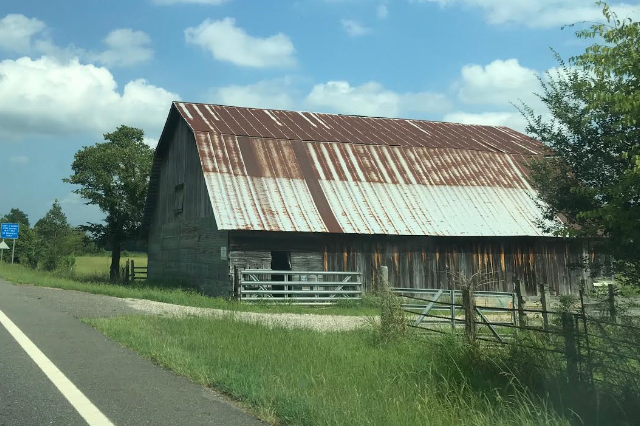
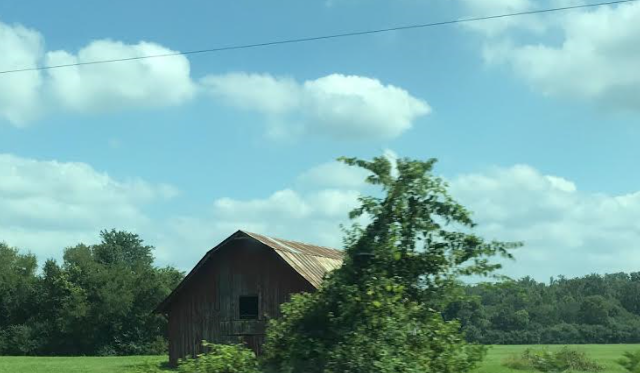
Mobley barn Hwy 27 N of Mt. Ida.
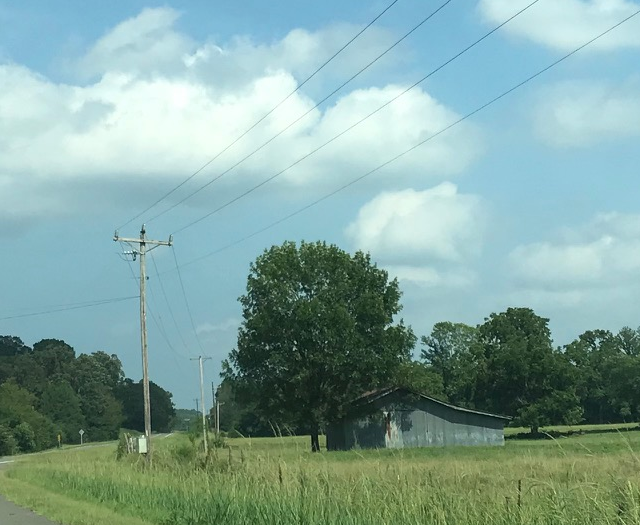
Quilt Trails Out of State
Sac Co.